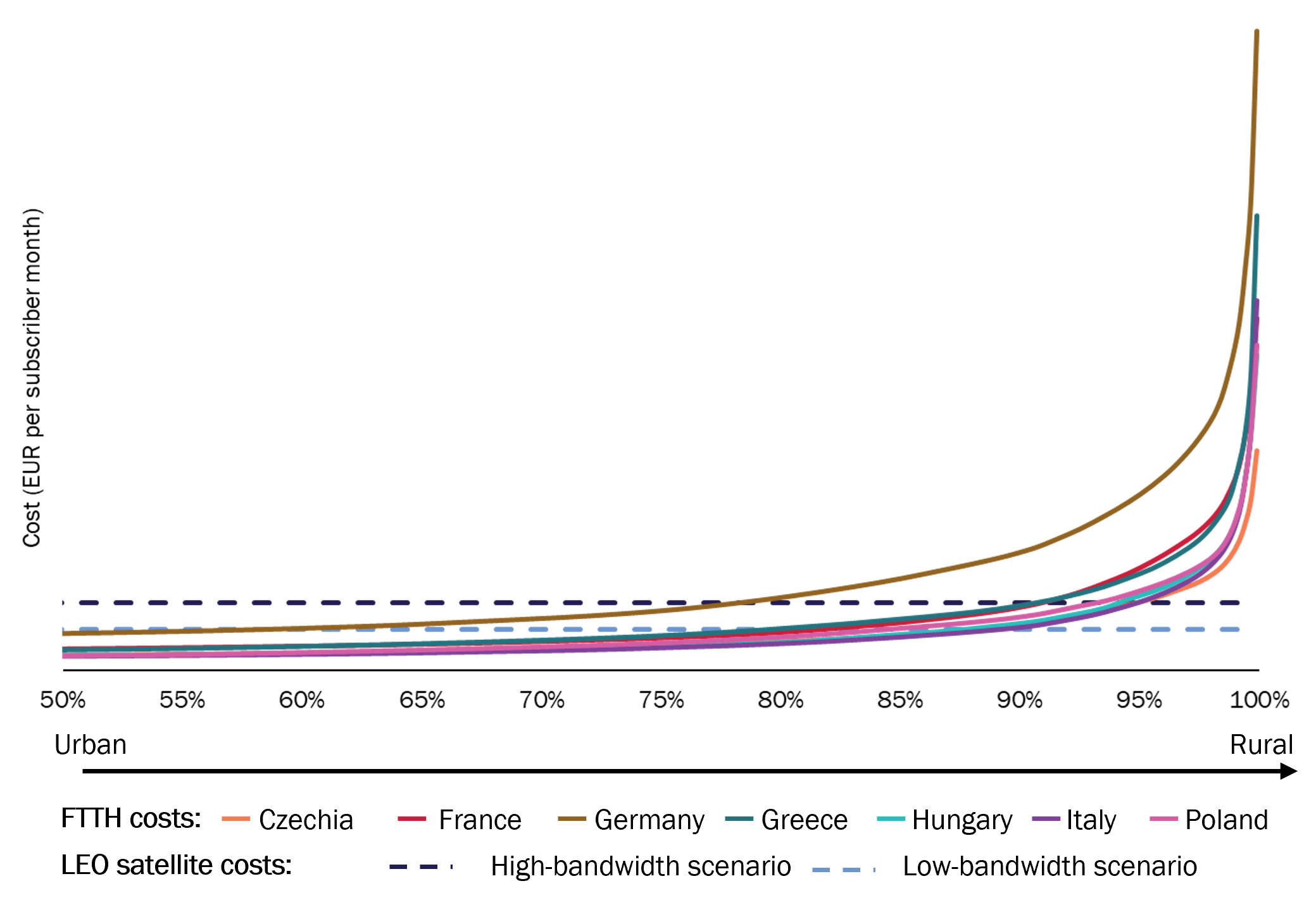LEO satellite broadband: a cost-effective option for rural areas of Europe
24 February 2025 | Strategy
Stela Bokun | Alexander Ohlsson | Andrew Daly | Lluc Palerm | Olly Jones | Neil Kiritharan | Luke Wyles
Report | PDF (47 pages)
Abstract
The European Commission’s Digital Decade goals include a target for nationwide gigabit-capable broadband by 2030 for all European Union (EU) member states. Fibre to the home (FTTH), the main technology that is expected to deliver on this ambitious target, has been receiving significant government support at a national and regional level. However, the cost of deploying FTTH increases exponentially as population density decreases, and on average across the EU, over 20% of households remain uncovered by gigabit-capable networks based on either FTTH or coaxial cable DOCSIS 3.1.1 The high cost of deploying FTTH in the most rural areas, and shortfall against connectivity targets to date, raise the question of whether complementary connectivity technologies could be used to fill coverage gaps more cost-effectively.
In this study, we consider the potential for LEO satellite broadband to meet end users’ needs in a more cost-effective manner than FTTH in the rural areas of seven EU countries: Czechia, France, Germany, Greece, Hungary, Italy and Poland. Our modelling approach is based on two distinct projections of future end-user data consumption: a high-bandwidth scenario and a low-bandwidth scenario. We thus present two sets of modelling outputs for each of the countries throughout the study.
Our main finding is that, while FTTH remains a good choice for the majority of households, there are compelling reasons to consider complementary technologies such as LEO satellite to serve more remote areas in a cost-effective manner. This finding is based on our estimates that LEO satellite constellations expected to be deployed by 2030 will have sufficient capacity to serve as many as 2.6 million to 4.2 million customers in the countries studied and that the technology could be more cost-effective than FTTH for 5–42% of households, depending on the country and the bandwidth scenario in question. Without factoring in existing FTTH network coverage, we estimate that relying on commercially offered LEO satellite broadband could save up to EUR21–26 billion in fibre subsidies that would be required to achieve nationwide fibre coverage in the seven EU countries considered (30–37% of the total subsidy required).
Figure 1: Comparison of estimated cost to deploy and operate an FTTH network against LEO satellite, by household density (most rural 50% of households) [Source: Analysys Mason, 2025]

Analysys Mason’s report was sponsored by Amazon, which has published the report on its website.
1 DOCSIS is short for Data Over Cable Service Interface Specification, a standard that allows data transfer (including internet access provision) over hybrid fibre-coaxial (HFC) cable; DOCSIS 3.1 (and 4.0) enable gigabit connectivity and therefore qualify as very-high-capacity networks (VHCNs) in the European Commission (EC) context.
*This report has been prepared by Analysys Mason, sponsored by Amazon, and is subject to Analysys Mason’s editorial judgement and discretion. The analyses contained within this report are the sole responsibility of Analysys Mason and do not necessarily reflect the views of Amazon.

LEO satellite broadband: a cost-effective option for rural areas of Europe
Authors

Stela Bokun
Partner, expert in strategy
Alexander Ohlsson
Principal
Andrew Daly
Principal
Lluc Palerm
Research Director, space and satellite, expert in satellite strategies for telcos
Olly Jones
Consultant
Neil Kiritharan
Consultant

